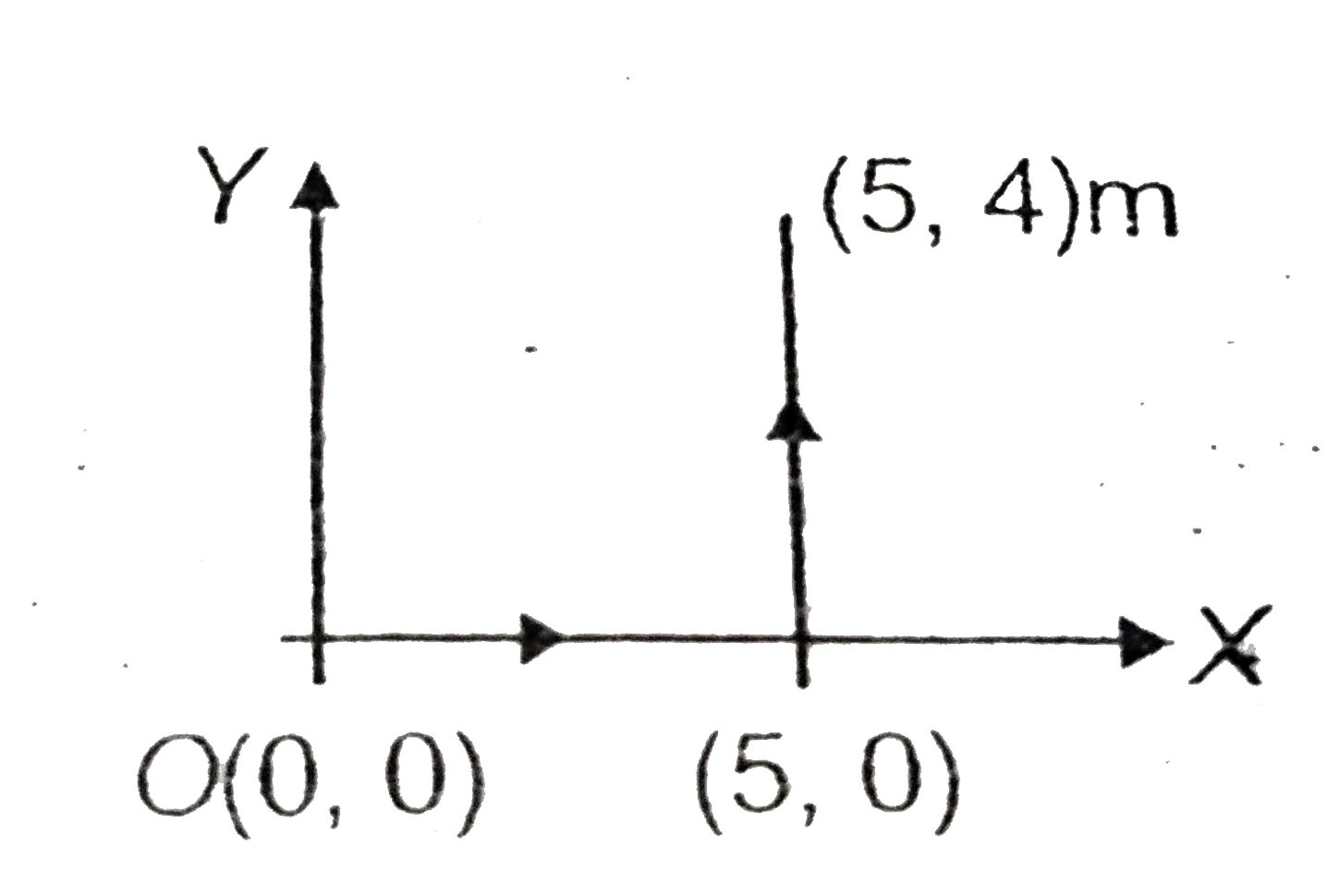A force where k is a positive constant acts on a particle moving in x-y plane starting from the point (3, 5), the particle is taken along a straight line to (5, 7). The work done by the force is :
zero
35 K
20 K
15 K
The correct Answer is:C
To find the work done by the force →F=k(y^i+x^j) on a particle moving from point A(3,5) to point B(5,7), we can follow these steps:
Step 1: Define the Force
The force acting on the particle is given by:
→F=k(y^i+x^j)
where k is a positive constant, y is the y-coordinate, and x is the x-coordinate of the particle.
Step 2: Parameterize the Path
The particle moves from point A(3,5) to point B(5,7). We can parameterize the path as follows:
Let x(t)=3+2t and y(t)=5+2t where t varies from 0 to 1. This gives us a straight line path from A to B.
Step 3: Calculate the Differential Displacement
The differential displacement vector d→r is given by:
d→r=dxdt^i+dydt^j=(2^i+2^j)dt
Step 4: Substitute the Parameterization into the Force
Substituting x(t) and y(t) into the force:
→F(t)=k((5+2t)^i+(3+2t)^j)
Step 5: Calculate the Work Done
The work done W by the force along the path from A to B is given by the integral:
W=∫BA→F⋅d→r
Substituting the expressions we have:
W=∫10→F(t)⋅(2^i+2^j)dt
Calculating the dot product:
→F(t)⋅d→r=k((5+2t)⋅2+(3+2t)⋅2)dt=k(2(5+2t)+2(3+2t))dt
=k(10+4t+6+4t)dt=k(16+8t)dt
Now, integrate:
W=k∫10(16+8t)dt=k(16t+4t2)10=k(16+4)=20k
Final Answer
Thus, the work done by the force is:
W=20k
The force acting on the particle is given by:
→F=k(y^i+x^j)
where k is a positive constant, y is the y-coordinate, and x is the x-coordinate of the particle.
The particle moves from point A(3,5) to point B(5,7). We can parameterize the path as follows:
Let x(t)=3+2t and y(t)=5+2t where t varies from 0 to 1. This gives us a straight line path from A to B.
The differential displacement vector d→r is given by:
d→r=dxdt^i+dydt^j=(2^i+2^j)dt
Substituting x(t) and y(t) into the force:
→F(t)=k((5+2t)^i+(3+2t)^j)
The work done W by the force along the path from A to B is given by the integral:
W=∫BA→F⋅d→r
Substituting the expressions we have:
W=∫10→F(t)⋅(2^i+2^j)dt
Calculating the dot product:
→F(t)⋅d→r=k((5+2t)⋅2+(3+2t)⋅2)dt=k(2(5+2t)+2(3+2t))dt
=k(10+4t+6+4t)dt=k(16+8t)dt
Now, integrate:
W=k∫10(16+8t)dt=k(16t+4t2)10=k(16+4)=20k
Thus, the work done by the force is:
W=20k
Topper's Solved these Questions
- WORK, POWER & ENERGY BOOK - MOTIONCHAPTER - WORK, POWER & ENERGY EXERCISE - Exercise - 2
30 Videos
- WORK, POWER & ENERGY BOOK - MOTIONCHAPTER - WORK, POWER & ENERGY EXERCISE - Exercise - 3 Section-A
25 Videos
- WORK, POWER & ENERGY BOOK - MOTIONCHAPTER - WORK, POWER & ENERGY EXERCISE - QUESTIONS FOR PRACTICE
25 Videos
- WAVESBOOK - MOTIONCHAPTER - WAVESEXERCISE - EXERCISE -4 (Level -II) (previous year JEE Advanced)
10 Videos
Similar Questions
A force F=−k(^ˆi+xˆj) (where k is a positive constant) acts on a particle moving in the x−y plane. Starting from the origin, the particle is taken along the positive x-axis to the point (a,0) and then parallel to the y-axis to the point (a,a). The total work done by the force F on the particle is
(a) −2ka2 , (b) 2ka2,(c)-ka^(2),(d)ka^(2)
View SolutionA force →F(yˆl+xˆJ), where K is a positive constant, acts on a particle moving in the XY-Plane. Starting from the origin, the particle is taken along the positive X-axis to a point (a,0) and then parallel to the y-axis to the point (a,a). Calculate the total work done by the force on the particle.
View Solution
Knowledge Check
A force F=−K(yˆi+xˆj) (where K is a positive constant) acts on a particle moving in the x-y plane. Starting from the origin, the particle is taken along the positive x-axis to the point (a,0), and then parallel to the y-axis to the point (a,a). The total work done by the force F on the particle is
A−2Ka2B2Ka2C−Ka2DKa2A force F=−K(yˆi+xˆj) (where K is a positive constant) acts on a particle moving in the x-y plane. Starting from the origin, the particle is taken along the positive x-axis to the point (a,0), and then parallel to the y-axis to the point (a,a). The total work done by the force F on the particle is
A−2Ka2B2Ka2C−Ka2DKa2A force F=−K(yˆi+xˆj) (where K is a positive constant) acts on a particle moving in the x-y plane. Starting from the origin, the particle is taken along the positive x-axis to the point (a,0), and then parallel to the y-axis to the point (a,a). The total work done by the force F on the particle is
A−2Ka2B2Ka2C−Ka2DKa2
A force →F=(4ˆi+5ˆj)N acts on a particle moving in XY plane. Starting from origin, the particle first goes along x-axis to the point (5.0) m and then parallel to the Y-axis to the point (5,4 m. The total work done by the force on the particle is

View SolutionA particle moves in x-y plane from (0,0) to (a,a) and is acted upon by a force →F=k(y2ˆi+x2ˆj)N, where k is a constant and x and y are coordinates in meter. Find work done by this force, if the particle moves along
Two straight lines first from (0,0) to (a,0) and then from (a,0) to (a,a)
View SolutionA force F=−K(yˆI+xˆj)(whereKisaposiveconstant)actsonapartic≤mov∈g∈thexypla≠.Start∈gformtheorig∈al,theparticalistakenalong∈thepositivexaξs→thep∮(x,0)andthenpartical→theyaξsthep∮(x,0).The→talworkdo≠bytheforceF on the particls is
View SolutionA force F=−K(yˆi+xˆj), acts on a particle moving in the x-y plane. Starting from the origin, the particle is taken along the positive x-axis to the point (a,0) and then parallel to the y-axis to the point (a, a). The total work done by the force is
View SolutionForces acting on a particle moving in a straight line varies with the velocity of the particle as F=αυ where α is constant. The work done by this force in time interval Δt is :
View Solution
